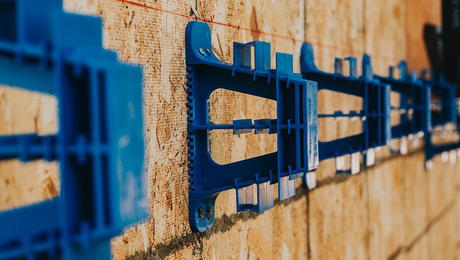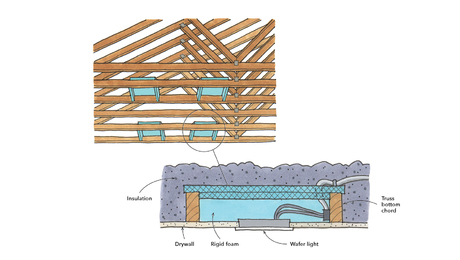Q:
We recently built a two-story Victorian house in northern Ohio. The contractor ran the hose from exhaust fans in the upstairs bathroom into the soffit cavity where he had installed continuous soffit vent. I’ve noticed that after snowstorms this winter, snow on the roof melts in streaks above the areas where the hose runs into the soffit even when the fans haven’t been running. Are my concerns theoretical, or should I lobby the builder for through-the-roof vents?
B. David Petersen, Ashland, OH
A:
Fred Lugano, a weatherization contractor in Vermont, replies: Your concerns are absolutely valid, not theoretical. By venting the bathroom exhaust fan into the soffit area, your builder has not created a distinct disconnection between the exhaust and the framing cavity, in this case your attic. In this debatable system of soffit and roof ventilation, the soffit vents are supposed to take in air that is then exhausted through the roof vents, in the process keeping the underside of the roof cold and dry. Running the hose from the bathroom exhaust fan into the soffit creates the risk of having that warm, moist air drawn into the attic. Instead, the exhaust fan should be vented to the outside via the shortest practical path, either through the roof or through a sidewall.
Your builder may have balked at using a roof vent because they are noticeably out of character with Victorian architecture. Roof vents are also subject to blockage in heavy snow, and they have been known to drip condensation back into bathrooms. However, I suspect that your snowmelt problems may be deeper than just an omitted roof vent, especially because you said that melting occurs even when the fan is not operating.
Before cutting into your roof, you need to crawl into your attic to find the exact source of the warm air causing the snow to melt. The first places to check are the fan unit and the hose itself. Fans are notorious for leaking air around their housings where they attach to the ceiling. I spray expanding foam around the unit to keep warm air from leaking out.
Next, make sure the hose is securely fastened to the exhaust port on the fan. I can’t tell you how many times I’ve seen problems from hoses either disconnected from fans, inadequately clamped to fans or missing altogether. Check the hose for any holes that might be leaking air. Vent hoses are fragile and can easily rip or tear. Also, if the hose is running horizontally to a sidewall vent, I bury the hose in cellulose insulation. If the hose runs to a roof vent, using insulated hose can cut down on the possibility of condensation.
Another possible culprit is recessed lighting, which can dump huge amounts of heated air into the attic. Recessed lights in attic-joist bays should be the type that have been approved for direct contact with insulation (IC-rated). I cover these fixtures with a drywall box caulked in place to the attic side of the ceiling to prevent warm air from leaking around their perimeter. Fixtures that have a “Fire Hazard” label should be replaced with new airtight IC-rated fixtures.
Caulk or foam around any other penetrations between heated areas and the attic, such as around plumbing stack vents. If you have forced hot-air heat, make sure that you seal around any attic-run ducts and that they are buried in insulation. Also, make sure that your return-air ducts are sized adequately and sealed to avoid pressurizing your house. Excess pressure from a hot-air furnace will blow warm air into the attic through the slightest hole.
Last, before you climb down, make sure that all the attic insulation is properly positioned in the joist bays. To be effective, the insulation must fully contact the heated surface. A batt of insulation thrown loosely over a fan or duct does nothing but block your view of the problem. While I don’t approve of running a bathroom vent into a ventilated soffit, taking all these other measures I outlined will do far more to affect localized roof melt and to improve the overall performance of your home than just moving the vent hose.
Fine Homebuilding Recommended Products
Fine Homebuilding receives a commission for items purchased through links on this site, including Amazon Associates and other affiliate advertising programs.

Shingle Ripper

Flashing Boot

Roofing Gun

























